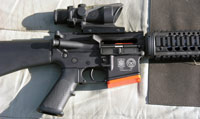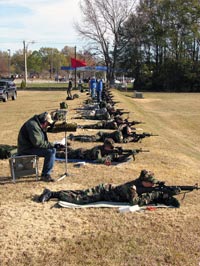A cadre of 40 volunteer civilian Military Rifle Instructors, who were selected and supported by the CMP, are now actively serving as instructors in U. S. Army Squad Designated Marksman Instructor Courses conducted by the U. S. Army Marksmanship Unit. The immediate result of their dedication is that the Army is now able to train many more instructors and soldiers in marksmanship skills that can significantly enhance their combat effectiveness.
 |
| CMP Military Rifle Instructor Brad Palmer provides on-the-line coaching to an Army NCO who is being trained as a SDM Instructor in a fast-growing USAMU course.
|
The Squad Designated Marksman (SDM) is a soldier who is trained in advanced marksmanship techniques that make him capable of delivering hits on man-sized targets at ranges from 200 to 500 meters. This is a distance that is well beyond the capabilities of the typical infantryman. The type of war being fought in the Global War On Terror where enemy combatants are intermixed with civilian noncombatants means that soldiers with advanced marksmanship skills are often the only means of engaging these elusive targets. The SDM program was developed to assure that each Army combat squad would have one soldier who is trained to perform as the designated marksman for that squad (SDM).
 |
| SDM Instructor students fire M16/AR15 SDM rifles equipped with ACOG scopes from the prone position, with a sling or bipod support.
|
Training soldiers to serve as SDMs proved to be a special challenge for the U. S. Army because, except for the Army Marksmanship Unit at Fort Benning, no other Army units possessed the knowledge and experience base to teach advanced marksmanship. When the requirement was identified, the Army Marksmanship Unit, which is home to the Army Rifle Team, quickly agreed to do everything it could to help the Army respond to these new training requirements.
To do this, USAMU developed an accurized M16 SDM rifle and produced 240 of them for deployment in Iraq with the 3rd Infantry Division. The Army Marksmanship Unit started teaching courses to train instructors how to train SDMs in their units (train-the-trainer) in October 2004. Soldiers trained by USAMU, who are usually NCOs, are expected to return to their units where they will teach Privates and PFCs to be SDMs in their squads.
 |
| Students in the SDM Instructor Course are taught to engage and hit targets at distances of 600, 500, 400 and 300 yards. By the end of a week of training, students typically are capable of scoring 80-90 percent hits on Army E silhouettes.
|
The demand for these courses quickly exceeded the ability of USAMU personnel to respond. This created a serious challenge because the marksmanship experience and expertise needed to teach these courses could not be found anywhere else in the Army. In an effort to find qualified instructors who could help the Army train more SDM instructors, USAMU Commander LTC David Liwanag came up with the idea of calling on civilian Distinguished Riflemen, many of whom had prior military experience, to supplement his instructor resources. In the winter and spring of 2005, civilian experts were called upon to help conduct SDM courses at Fort Hood, Texas and Fort Campbell, Kentucky.
 |
| CMP Military Rifle Instructors who supported the Army SDM Instructor Training Course at Fort Benning on 5-9 December 2006 were (l. to r.) Brad Palmer, Manchester, CT; John Grubbs, Clayton, IN; Will Smith, Clinton, UT and Mark Mann, Prospect, KY.
|
Positive experiences with those civilian volunteers led to conversations between USAMU and the CMP to formalize this program by recruiting and training a larger number of qualified civilians with expertise in long-range service rifle marksmanship to support Army SDM training. The initial call for qualified civilian volunteers was released through the CMP’s First Shot On-Line in May 2005. The qualifications were high; applicants were expected to be Distinguished Riflemen or to have extensive service rifle competition accomplishments. They also had to have the ability and knowledge to not only teach marksmanship, but to be able to work in a military training environment. Preference was given to individuals with prior military experience because they would be better equipped to work effectively in a military environment.
52 individuals were selected for training as candidates for this program and were invited to Camp Perry in June 2005 to participate in a training program created by USAMU instructors. Their rigorous training program concluded with a knowledge exam and a requirement to conduct actual instruction in one or more SDM topics. Subsequent to the training and evaluation, 40 individuals were selected and certified as CMP Military Rifle Instructors. Deployment of the new CMP Military Rifle Instructors (MRI) began in September.
A typical training team includes two or three USAMU NCOs who are in charge of the course and act as lead instructors. Four CMP MRIs are assigned to support them and act as assistant instructors. CMP MRIs work primarily with small groups of students during firing exercises. Students receive printed SDM manuals and instructional CDs provided by the CMP. The SDM instructor training course typically lasts one week, from Monday through Friday. Approximately 10% of the course work is in the classroom. The remainder is spent in range firing exercises. SDM students fire in excess of 500 rounds during the week at ranges from 300 to 600 yards.
 |
| The CMP cooperated with Armalite to provide AR15 rifles that were accurized by USAMU armorers and equipped with ACOG combat scopes. These rifles are now used to train Army SDM instructors.
|
Since accurized M16 SDM rifles are not yet available through Army supply channels, the CMP worked with the Armalite Corporation to provide AR15 SDM rifles that were reworked by USAMU armorers so they could be used by SDM instructor trainees in these courses.
Since September 2005, USAMU has conducted eight SDM instructors courses where volunteer CMP MRIs were part of the instructional team. Two courses were at Fort Riley, Kansas; one at Fort Hood, Texas and the other five at Fort Benning. To date these courses have trained 304 instructors, most of whom will return to their units to train several hundred more SDMs. The potential impact of these courses is huge.
 |
| A relay of SDM Instructor students fires on Fort Benning’s Easley Range at 600 yards distance. CMP Military Rifle Instructors are working with students on the line.
|
The quality of training provided by these courses is impressive. Training courses typically have up to 40 students. Most students arrive without previous marksmanship experience except for basic instruction received during Army training. Most firing is done with bipods mounted on the rifles or in the prone position with slings. Firing is done on Army “E” silhouette targets (the same target used in the Infantry Trophy Match at 600 & 500 yards). By the end of the course, students do “shoot-downs” where they zero their weapons, then fire 10 shots each at 600, 500, 400 and 300 yards, without targets being marked to indicate group locations. Hit counts in this exercise typically range from 40 to lows in the high 20s. This is impressive marksmanship for students who start with no previous marksmanship experience and have only three or four days of practice. SDM Instructor students also learn a great deal about marksmanship concepts like trajectory, wind and distance estimation and specific marksmanship techniques that will enable them to more effectively teach soldiers in their units. Perhaps most importantly, SDM Instructor students leave the course with a very high level of confidence that they can readily hit man-sized targets at distances of 200 to 500 meters.
 |
| An Army SDM Instructor student prepares to fire from the prone position.
|
Between now and September, 2006, USAMU already has scheduled an additional ten SDM instructor courses that will be supported by CMP MRIs. All 40 of the current CMP MRIs will be asked to serve in one or more courses in order to staff these courses. With more calls coming to USAMU every day for additional student slots and more courses, it is clear that the roster of CMP Military Rifle Instructors will have to be increased.
A second training course for a new class of CMP MRIs will be conducted by USAMU at Camp Perry on 15-18 August, immediately after the 2006 National Matches. Qualified individuals who would like to apply for acceptance into this program are invited to submit applications. Individuals selected for the program must meet the following qualifications:
- Have earned the Distinguished Rifleman Badge or have other similar competitive accomplishments in service rifle shooting.
- Have prior experience as a marksmanship instructor or coach.
- Prior service in the U. S. Armed Services is highly desired.
- Be physically fit and capable of working and instructing in outdoor environments for one- week assignments with 10-12 hour workdays.
- Have sufficient time available to attend an initial one-week training session and to work in one or two one-week training courses per year.
CMP MRIs serve on a volunteer basis, but their travel expenses are reimbursed while they are on assignments. MRIs are assigned to work as members of instructional teams that travel to military installations to conduct SDM courses. MRIs work under the direction of an Army NCO team leader.
The CMP Military Rifle Instructor program is unique not only because it gives qualified civilians an opportunity to contribute to the national defense, but it also fulfills the original purpose of the CMP when the Congress and President Theodore Roosevelt founded the program in 1903. They envisioned that the National Matches and the “civilian marksmanship program” would be a means of preparing young Americans to serve more effectively in the Armed Services.
Qualified individuals interested in applying to serve in this program may download the application form from the CMP web site at http://www.odcmp.com/Programs/MRIApp.pdf. Complete the form and fax it to 419-635-2565 or mail it to Sheri Judd, CMP SDM Program, P. O. Box 576, Port Clinton, OH 43452. To obtain additional information contact Sheri Judd at sdm@odcmp.com.
|




